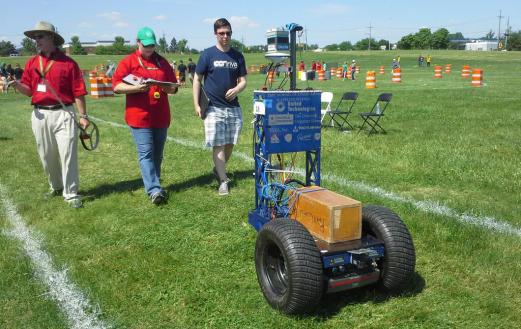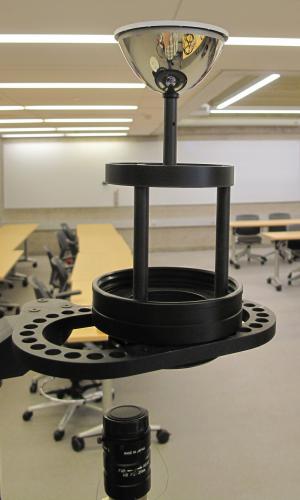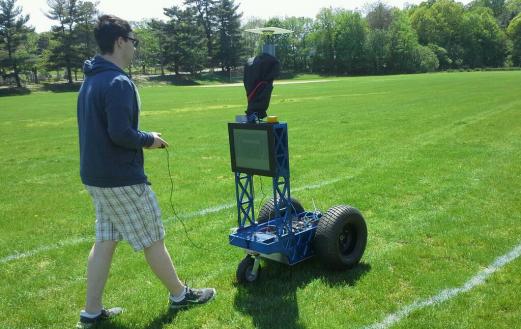Intelligent Vehicle team wins ‘rookie of the year’ in international competition

What’s deep blue; rides on three wheels; orients itself with a laser rangefinder, a differential GPS solution, and a camera pointed up at a convex mirror; and likes to avoid traffic cones while roaming around between painted white lines?

That would be “Armstrong” — after the jazz trumpeter, Louis — the Yale Undergraduate Intelligent Vehicles (InVē) team’s first robot. If you’ve been anywhere near the Center for Engineering Innovation & Design this past spring, you may have met him — and if this past weekend you were with the more than 40 international teams at the 22nd annual Intelligent Ground Vehicle Competition (IGVC), you probably saw him earn the Rookie-of-the-Year Award for an overall 4th place finish.
The rules of IGVC are simple: each team’s autonomous robotic vehicle must drive to a series of GPS waypoints without running into the field’s many obstacles or running out of time. “The major challenge comes from sensing,” says InVē team member Alex Carrillo, “sensing our GPS location, sensing lines painted in the grass that we can’t cross. We also have to not hit the traffic barrels, and there are two colors of flags that we have to segment out with our camera and navigate around differently, depending on if they’re red or blue. So we put a lot of time into machine vision.”

That vision comes from one of Armstrong’s most unique features: A camera that — instead of looking forward, backward, and out to the sides — views the robot’s entire 360-degree surroundings by looking up at a convex mirror. The InVē team, founded last August by a group of enterprising freshmen and sophomores, chose the design last fall while researching intelligent ground vehicle best practices. The system, though relatively uncommon, intrigued the team because of its elegance, and with the sensing mechanism decided on, the team buckled down for a spring semester of writing their software and designing and fabricating their robot. “We’re a six member team of programmers, mostly electrical engineers and computer scientists,” says Carrillo. “So we’ve had to figure out how to do the mechanical engineering stuff like computer-aided manufacturing, and machining nice looking triangles into our chassis. Challenge is a big part of our spirit.”
The challenge of IGCV is so high that, despite a painstaking ground speed that Carrillo likens to the boardgame Operation, most competing robots do not reach the finish line, their score instead calculated by the distance travelled before they hit an obstacle. “As simple as it sounds, even finding white painted lines on the grass is a nontrivial problem,” says Carrillo. “The paint takes on the grassy texture, with all its variations in shadow. So the real creativity comes from how people think about the data, how they deal with the information handed to them in order to, say, detect obstacles. Seeing a bunch of these robots, it can be hard to tell the differences because the creativity is all in the computer.”
Which isn’t to suggest that the hardware can be overlooked. The InVē team is quick to point out that their robot only exists thanks to lead-sponsor United Technologies Corporation, who provided essential funding for construction, and the many other companies that donated essential hardware, such as a GPS system from OmniSTAR and an inertial measurement system from VectorNav. Even Armstrong’s lustrous blue paint job was a gift from Giering Metal Finishing — a perhaps nonessential addition, but a unique one that Carrillo says “gets people asking questions” about the project.

One of their most important “sponsors” was the IGVC team at the United States Military Academy at West Point, especially that team’s faculty advisor, Colonel Robert Sadowski. “We met Colonel Sadowski in a Yale class last spring,” says Carrillo. “In fact, he was the one who first got us excited about IGVC, and he’s been a major supporter ever since. In addition to mentoring us, his team lent us crucial starting hardware to get us off the ground, and even now we’re using their laser rangefinder. But the biggest thing they did is drive Armstrong to the competition for us — I can’t imagine what it would cost to FedEx this thing.”
Now, with Armstrong back at Yale, the team is looking forward to next year’s competition — though they’re not sure which competition that will be. “We chose IGVC because it’s a really fun experience to get together with other skilled people and solve a problem, especially one that enabled us to learn a wide breadth of skills,” says Carrillo. “But our vision for the future is to tackle all sorts of robotics projects. We’re all rising sophomores and juniors, with another couple years to build our team infrastructure while learning lots of really random things. So next year we’re looking at a couple of underwater and seafaring robotics competitions. It’s a lot of fun to put together a project — from conceptualizing it, thinking about the problems at hand, and then a couple of months down the road having in front of you a realized version of what you were thinking. And we can’t wait to do that again.”

